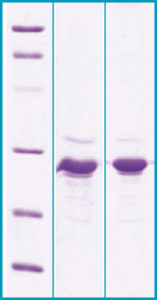Angiopoietin-Like Protein 3 Human E. coli
Angiopoietin-like proteins ANGPTL3 and ANGPTL4 are secreted proteins mainly expressed in liver that have been demonstrated to regulate triglyceride metabolism by inhibiting the lipolysis of triglyceride-rich lipoproteins. ANGPTL3 is structurally similar to angiopoietins, which are vascular endothelial growth factors. The experimental results show that Angptl3 and Angptl4 function to regulate circulating triglyceride levels during different nutritional states and therefore play a role in lipid metabolism during feeding/fasting through differential inhibition of Lipoprotein lipase (LPL). Using deletion mutants of human ANGPTL3, it was demonstrated that the N-terminal domain containing fragment – (17–207) and not the C-terminal fibrinogen-like domain containing fragment – (207–460) increased the plasma triglyceride levels in mice. The fasting-induced adipose factor (FIAF, ANGPTL4, PGAR, HFARP) was identified as an adipocytokine up-regulated by fasting, by peroxisome proliferator-activated receptor agonists, and by hypoxia. At the protein level, in human and mouse blood plasma, FIAF was found to be present both as a native protein and in a truncated form. Differentiation of mouse 3T3-L1 adipocytes was associated with the production of truncated FIAF, whereas in human white adipose tissue and SGBS adipocytes, only the native FIAF could be detected. Interestingly, the truncated FIAF was produced by human liver. Experimental data suggest that FIAF is mainly presented in human blood plasma in a truncated form (FIAF-S2), whose level is increased by fenofibrate treatment. Levels of both truncated and native FIAF showed marked inter individual variation but were not associated with body mass index and were not influenced by prolonged semistarvation.
Type
Recombinant
Description
Total 223 AA. MW: 26 kDa (calculated). UniProtKB acc.no. Q9Y5C1. N-Terminal His-tag, 16 extra AA (highlighted).
Source
E. coli
Purity
Purity as determined by densitometric image analysis: >95%
SDS-PAGE Gel
12% SDS-PAGE separation of Human ANGPTL3
1. M.W. marker – 14, 21, 31, 45, 66, 97 kDa
2. reduced and heated sample, 5μg/lane
3. non-reduced and non-heated sample, 5μg/lane

Biological Activity
Effects of ANGPTL3 on serum levels of triglycerides, on blood glucose and on serum cholesterol levels in C57BL/6J mice.
Endotoxin
< 1.0 EU/ug
Formulation
Filtered (0.4 μm) and lyophilized in 0.5 mg/mL in 0.05M Acetate buffer pH 4.0
Reconstitution
Add 0.1M Acetate buffer pH4 to prepare a working stock solution of approximately 0.5 mg/mL and let the lyophilized pellet dissolve completely. For conversion into higher pH value, we recommend intensive dilution by relevant buffer to a concentration of 10μg/mL. In higher concentrations the solubility of this antigen is limited. Filter sterilize your culture media/working solutions containing this non-sterile product before using in cell culture.
Applications
Western blotting, ELISA, Biologically active protein
Shipping
At ambient temperature. Upon receipt, store the product at the temperature recommended below.
Storage/Expiration
Store the lyophilized protein at –80 °C. Lyophilized protein remains stable until the expiry date when stored at –80 °C. Aliquot reconstituted protein to avoid repeated freezing/thawing cycles and store at –80 °C for long term storage. Reconstituted protein can be stored at 4 °C for a week.
Quality Control Test
BCA to determine quantity of the protein.
SDS PAGE to determine purity of the protein.
LAL to determine quantity of endotoxin.
– Robciuc MR, Tahvanainen E, Jauhiainen M, Ehnholm C. Quantitation of serum angiopoietin-like proteins 3 and 4 in a Finnish population sample. J Lipid Res. 2010 Apr;51 (4):824-31
– Stejskal D, Karpisek M, Humenanska V, Solichova P, Stejskal P. Angiopoietin-like protein 3: development, analytical characterization, and clinical testing of a new ELISA. Gen Physiol Biophys. 2007 Sep;26 (3):230-3

